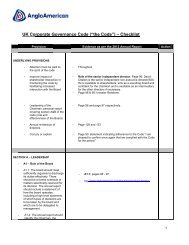Creating Value with the Future in Mind - Anglo American South Africa
Creating Value with the Future in Mind - Anglo American South Africa
Creating Value with the Future in Mind - Anglo American South Africa
Create successful ePaper yourself
Turn your PDF publications into a flip-book with our unique Google optimized e-Paper software.
<strong>Anglo</strong> <strong>American</strong> assessment of strategic, operational, project and susta<strong>in</strong>able development related risks<br />
1. Identify<strong>in</strong>g risks<br />
A consistently applied<br />
methodology is used to identify<br />
key risks across <strong>the</strong> Group; at<br />
bus<strong>in</strong>ess units, operations<br />
and projects. This has been<br />
effected through <strong>the</strong><br />
development, roll-out and<br />
ongo<strong>in</strong>g implementation of<br />
a Group Integrated Risk<br />
Management Standard.<br />
2. Analys<strong>in</strong>g risks and<br />
controls to manage<br />
identified risks<br />
Once identified, <strong>the</strong> process<br />
evaluates identified risks to<br />
establish root causes, f<strong>in</strong>ancial<br />
and non-f<strong>in</strong>ancial impacts<br />
and likelihood of occurrence.<br />
Consideration of risk treatments<br />
is taken <strong>in</strong>to account to<br />
enable <strong>the</strong> creation of a<br />
prioritised register.<br />
3. Determ<strong>in</strong><strong>in</strong>g<br />
management actions<br />
required<br />
Effectiveness and adequacy<br />
of controls are assessed.<br />
If additional controls are<br />
required <strong>the</strong>se are identified<br />
and responsibilities assigned.<br />
4. Report<strong>in</strong>g and monitor<strong>in</strong>g<br />
Management is responsible for<br />
monitor<strong>in</strong>g progress of actions<br />
to treat key risks and is<br />
supported through <strong>the</strong> Group’s<br />
<strong>in</strong>ternal audit programme,<br />
which evaluates <strong>the</strong> design<br />
and effectiveness of controls.<br />
The risk management process<br />
is cont<strong>in</strong>uous; key risks are<br />
reported to <strong>the</strong> Audit<br />
Committee <strong>with</strong> susta<strong>in</strong>ability<br />
risk also be<strong>in</strong>g reported to <strong>the</strong><br />
S&SD Committee.<br />
Our approach<br />
Our material issues<br />
The material issues we have<br />
identified from our <strong>in</strong>ternal<br />
and external processes <strong>in</strong><br />
2012 closely mirror those<br />
identified and reported <strong>in</strong> 2011.<br />
The pr<strong>in</strong>cipal change is that<br />
<strong>the</strong> relative importance of<br />
government and labour<br />
relations has grown follow<strong>in</strong>g<br />
events <strong>in</strong> <strong>South</strong> <strong>Africa</strong> dur<strong>in</strong>g<br />
<strong>the</strong> year. Here, we outl<strong>in</strong>e <strong>the</strong><br />
seven <strong>the</strong>mes that we use to<br />
frame and report on our key<br />
material issues.<br />
Compliance, permitt<strong>in</strong>g<br />
and licence to operate<br />
Failure to meet <strong>the</strong> compliance<br />
requirements of a chang<strong>in</strong>g and<br />
<strong>in</strong>creas<strong>in</strong>gly demand<strong>in</strong>g regulatory<br />
environment, or to understand<br />
<strong>the</strong> expectations of government,<br />
poses a risk to all parts of our<br />
bus<strong>in</strong>ess. Our social and legal<br />
licences to operate stem largely<br />
from our ability to demonstrate<br />
compliance <strong>with</strong> permitt<strong>in</strong>g<br />
requirements, responsible<br />
environmental management and<br />
<strong>the</strong> equitable distribution of <strong>the</strong><br />
economic value generated by<br />
our operations.<br />
For more <strong>in</strong>formation<br />
see pages 24–67<br />
Community development<br />
The legitimacy of <strong>the</strong> m<strong>in</strong><strong>in</strong>g<br />
<strong>in</strong>dustry, particularly <strong>in</strong> develop<strong>in</strong>g<br />
countries, depends on its ability to<br />
contribute to <strong>the</strong> well-be<strong>in</strong>g and<br />
prosperity of host communities.<br />
Our development solutions must<br />
make a positive impact and endure<br />
beyond m<strong>in</strong>e closure. The failure to<br />
secure or reta<strong>in</strong> support from our<br />
host communities as a result<br />
of rapidly chang<strong>in</strong>g societal<br />
expectations, or through<br />
<strong>in</strong>appropriately managed social,<br />
health, human rights or<br />
environmental impacts at our<br />
operations, could have a material<br />
impact on <strong>the</strong> bus<strong>in</strong>ess.<br />
For more <strong>in</strong>formation<br />
see pages 24–35<br />
Human rights<br />
<strong>Anglo</strong> <strong>American</strong> has a longstand<strong>in</strong>g<br />
commitment to <strong>the</strong><br />
Universal Declaration of Human<br />
Rights and we support <strong>the</strong> UN<br />
Guid<strong>in</strong>g Pr<strong>in</strong>ciples on Bus<strong>in</strong>ess<br />
and Human Rights. We are<br />
conscious that many aspects of<br />
our bus<strong>in</strong>ess can impact on human<br />
rights – <strong>in</strong>clud<strong>in</strong>g operational<br />
safety, employment conditions,<br />
land acquisition, water use, security<br />
provision and engagement <strong>with</strong><br />
Indigenous Peoples. We are<br />
committed to identify<strong>in</strong>g and<br />
manag<strong>in</strong>g <strong>the</strong>se risks.<br />
For more <strong>in</strong>formation<br />
see pages 32–33<br />
Water<br />
Over <strong>the</strong> past few years, water has<br />
become one of <strong>the</strong> most critical<br />
factors <strong>in</strong> our social and legal<br />
licence to operate. It has been a<br />
key po<strong>in</strong>t of debate at a number<br />
of projects, <strong>in</strong>clud<strong>in</strong>g our copper<br />
projects at Quellaveco (Peru) and<br />
Pebble (Alaska). With<strong>in</strong> our exist<strong>in</strong>g<br />
operations, <strong>the</strong> pr<strong>in</strong>cipal risk factors<br />
are security of supply, competition<br />
<strong>with</strong> o<strong>the</strong>r users, <strong>in</strong>creased unit<br />
costs and more str<strong>in</strong>gent water<br />
quality legislation.<br />
For more <strong>in</strong>formation<br />
see pages 56–59<br />
Climate change and energy<br />
New policy measures are lead<strong>in</strong>g to<br />
<strong>in</strong>creas<strong>in</strong>g energy and compliance<br />
costs, <strong>in</strong>clud<strong>in</strong>g potentially<br />
significant costs from carbon<br />
pric<strong>in</strong>g. We are witness<strong>in</strong>g<br />
chang<strong>in</strong>g expectations from our<br />
<strong>in</strong>vestors, communities and<br />
customers <strong>in</strong> relation to carbon<br />
management. We face <strong>in</strong>creased<br />
risks associated <strong>with</strong> <strong>the</strong> physical<br />
impacts of climate change on our<br />
operations and neighbour<strong>in</strong>g<br />
communities. Climate change<br />
also presents opportunities <strong>in</strong> <strong>the</strong><br />
form of environmentally friendly<br />
technologies used <strong>in</strong> our operations<br />
and those which use our products,<br />
as well as reputational benefits.<br />
For more <strong>in</strong>formation<br />
see pages 60–63<br />
Employee health and safety<br />
A safe and healthy workforce is an<br />
engaged and productive workforce.<br />
Effectively manag<strong>in</strong>g workplace<br />
safety, occupational health, and<br />
employee wellness (<strong>in</strong>clud<strong>in</strong>g <strong>the</strong><br />
management of diseases such<br />
as HIV/AIDS and TB) is a direct<br />
<strong>in</strong>vestment <strong>in</strong> <strong>the</strong> long-term health<br />
of <strong>the</strong> bus<strong>in</strong>ess, its employees and<br />
our associated host communities.<br />
For more <strong>in</strong>formation<br />
see pages 44–51<br />
Workforce management<br />
Meet<strong>in</strong>g our growth objectives<br />
depends on ensur<strong>in</strong>g access to <strong>the</strong><br />
relevant skills necessary to meet<br />
our bus<strong>in</strong>ess needs, hav<strong>in</strong>g <strong>the</strong><br />
systems <strong>in</strong> place to develop and<br />
reta<strong>in</strong> talent, and ma<strong>in</strong>ta<strong>in</strong><strong>in</strong>g<br />
positive relations <strong>with</strong> all our<br />
employees and trade unions.<br />
For more <strong>in</strong>formation<br />
see pages 40–43<br />
<strong>Anglo</strong> <strong>American</strong> plc Susta<strong>in</strong>able Development Report 2012 13



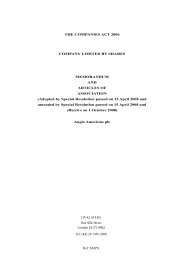
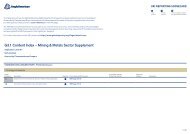
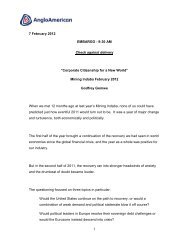
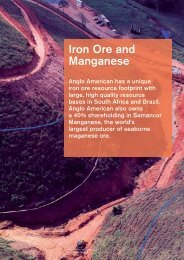
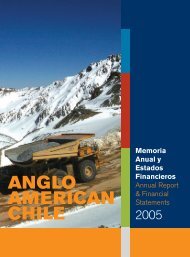
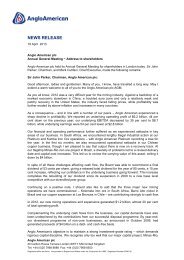
![English PDF [ 189KB ] - Anglo American](https://img.yumpu.com/50470814/1/184x260/english-pdf-189kb-anglo-american.jpg?quality=85)
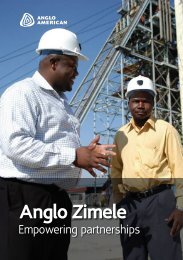

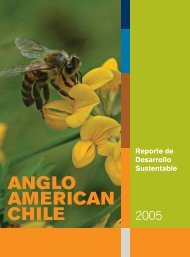

![pdf [ 595KB ] - Anglo American](https://img.yumpu.com/49420483/1/184x260/pdf-595kb-anglo-american.jpg?quality=85)
![pdf [ 1.1MB ] - Anglo American](https://img.yumpu.com/49057963/1/190x240/pdf-11mb-anglo-american.jpg?quality=85)
